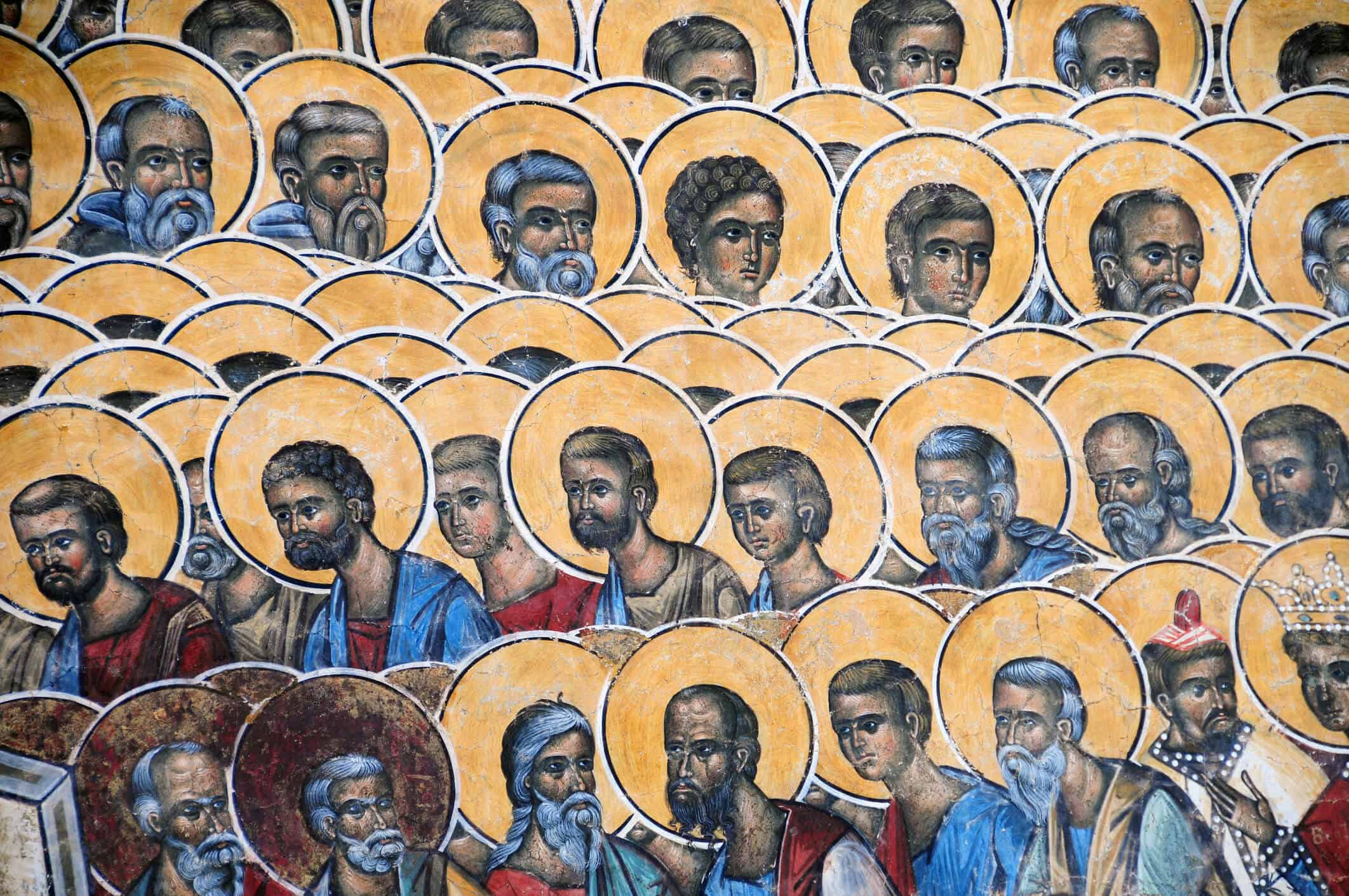July 1
St. Junipero Serra
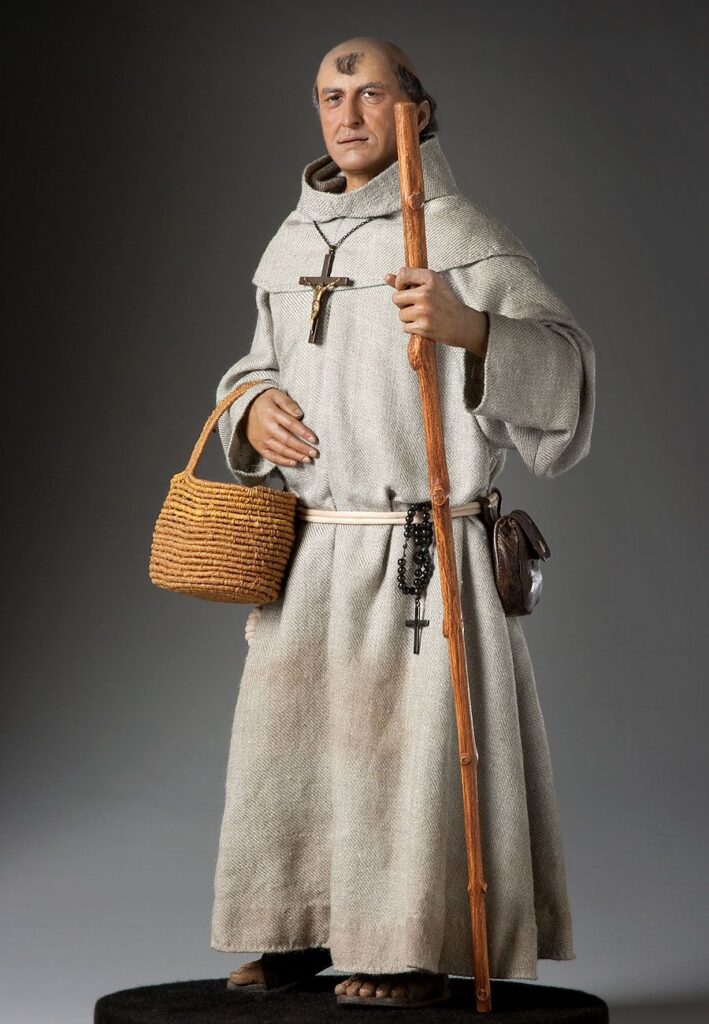
“We found on our journey, as well as in the place where we stopped, that they treated us with as much confidence and good-will as if they had known us all their lives.”
St. Junipero Serra
Junípero Serra, the “Apostle of California,” was born in 1713 at Petra, Majorca, Spain, the son of farmers. He went to the local Franciscan school and moved to Palma to become a novice at the Convento de Jesus in September 1730. entered the order, making his profession at eighteen years of age. After ordination, higher studies in philosophy and theology led Junípero to a professorial appointment. Yet he longed to join the missions to the New World.
In 1749, he was given leave to sail for Mexico. After Junípero arrived in Vera Cruz, he traveled 250 miles on foot to Mexico City; during the course of his journey, he suffered an injury to his leg from an infected insect bite that caused him pain for the rest of his life. In the years that followed, he catechized the native Pame Indians. He served as head of a mission, preacher, and professor.
In 1769, Junípero founded the first of his nine Californian missions— centers of culture as much as outposts of faith – at San Diego. Twenty-one California missions would be founded in all. In the process, the intrepid Junípero traveled 25,000 miles, most of it on foot, despite suffering from an ulcerated wound on his leg and persistent asthma. In 1776, he founded Mission San Juan Capistrano, now famous for its annually returning swallows. San Juan was the seventh of nine missions established under his direction.
Serra spent the rest of his life devoted to his evangelical work in the region. In trying to bring his religion to the Native Americans sometimes led to clashes with his own government. He clashed with Spanish authorities over the way soldiers treated the native peoples. He made the long trip to Mexico City to settle great differences with the military commander. He arrived at the point of death. The outcome was substantially what Junipero sought: the famous “Regulation” protecting the Indians and the missions. It was the basis for the first significant legislation in California, a “Bill of Rights” for Native Americans. He brought the Native Americans not only the gift of faith but also a decent standard of living.
In the final three years of his life, he revisited each mission to grant confirmation to those he had previously baptized. He died at Mission San Carlos Borromeo de Carmelo, where his grave can be found today.
July 6
St. Maria Goretti
Maria was born on October 16, 1890 in Corinaldo, in the Province of Ancona, then in the Kingdom of Italy. Her family’s prospects were so diminished that, at the age of five, her family was forced to give up their farm and work for other farmers. When she was nine, her mother and father moved to Ferriere di Conca in an effort to find better fields to till. They lived in an old barn that they shared with another family, the Serenellis, which included Giovanni Serenelli and his son, Alessandro. Two years into this venture, Maria’s father died of malaria. Her mother Assunta continued the backbreaking work and increasingly relied on Maria for help with the other five children.
When her mother broke the news to Maria that her First Communion would have to be put off because there was no time for her to be prepared. Maria was not daunted. She found the time to go to town for catechism lessons, and at twelve she was able to receive our Lord. She became a regular communicant and often was seen with a rosary wrapped about her fingers.
Only a few months later, twenty-year-old Alessandro Serenelli came in from the fields one day and attempted to sexually assault the twelve-year old Maria. Even as Maria fought his advances, her concern was for Alessandro’s soul. Despite his choking her, she refused to submit. He stabbed her cruelly with an awl, eleven times. As she tried to reach the door, he stabbed her three more times. She was found still alive, and taken to the hospital The following day, having expressed forgiveness for Alessandro and stating that she wanted to have him in Heaven with her, she succumbed to her injuries.
Alessandro was quickly captured. Subject to life imprisonment, his sentence was commted to 30 years, due to his age and relative lack of maturity. After three years in prison, he repented after a dream of Maria giving him a lily of peace that burned his hands. When he was released from prison, he sought and was given forgiveness by Assunta Goretti; they attended mass together the following day. Both he and Assunta attended Maria’s canonization proceedings in 1950. He spent the rest of his life as a lay brother of the Capuchin order, dying in 1970.
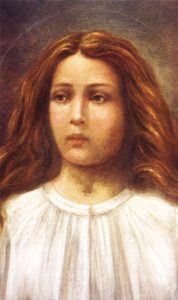
July 9
St. Mark Ji Tianxiang
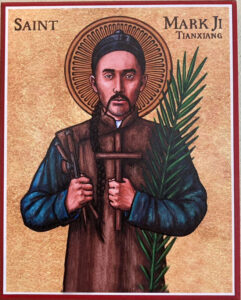
Saint Mark Ji Tianxiang was born the year 1834 in the northern province of Hebei, China. He was raised in a Catholic family and grew up to be a Catholic man of good morals. He went to medical school, married, and became a well-off doctor. He was a leader in the Christian community, and served the poor for free. One day, he came down with a violent case of a stomach illness that left him incapacitated. The common home remedy of the time in China was opium, and while it helped his stomach pain, he also became addicted and dependent on the drug.
But TianXiang threw himself onto the mercy of God, Despite being cut off from the sacraments, Tianxiang still struggled with his addiction and continued praying and asking the Lord for deliverance from his affliction. For thirty years, he went to Church daily despite not being able to receive any of the sacraments. For those same thirty years, he remained addicted to opium. He prayed that he might die a martyr, as he couldn’t see any other way out of his addiction.
In 1900, the Boxer Rebellion in China turned public opinion in China against all foreigners, including Catholics. Militia United in Righteousness, expelled missionaries and persecuted Christians across China.he Boxers, or “Militia United in Righteousness” expelled missionaries and persecuted Christians across China. Thirty-two thousand Chinese Christians and 200 foreign missionaries were killed., including Tianxiang.
His entire family, including his son, two daughters-in-law, and six grandchildren were rounded up by the Boxers to be executed. He begged his captors to be executed last, so that none of his family had to die alone. One by one, he watched each of his family members beheaded. When one of his grandson’s asked what was happening and where they were going, Tianziang replied, “We are going home.” Finally, he was the last left, and as he was beheaded, he died singing the Litany of the Blessed Virgin Mary.
July 11
St. Benedict of Nursia
St. Benedict was born into a noble Roman family at Nursia in Umbria in about 480; his twin sister was St. Scholastica. He was sent to Rome to be educated, but was confounded by the apathetic attitude of his fellow students. He fled to live a solitary life at Subiaco as a hermit. After living in a cave in the mountains for two years as a hermit, he had acquired such a reputation that disciples came in numbers to join him and important Roman families entrusted him with the education of their children. Some monks asked him to be their leader, but were so resentful of his discipline that they tried to poison him; Benedict blessed the cup of poison and it shattered.
He returned to his cave, but soon after, more followers begged him for his leadership. In the beginning he founded twelve small monasteries where monks lived in groups of twelve. . He reformed monastic life, by applying a strict discipline to those who followed him. Under his guidance, as abbot, the monks vowed to seek God and devoted themselves to work and prayer.
A few years later St. Benedict left the district of Subiaco to found the great abbey of Monte Cassino on the heights of Campania, north of Naples. There he wrote his Rule in which are wonderfully combined the Roman genius and the monastic wisdom of the Christian East. The Rule became the engine that completely reformed monastic life at that time. and through the Middle Ages. It prescribed a life of liturgical prayer, study, manual labor, and living together in community under a common abbot. The rule is still observed by two great monastic orders: The Benedictines themselves and the Cistercians.
St. Benedict died in 547, just a few days after his twin sister, St. Scholastica.
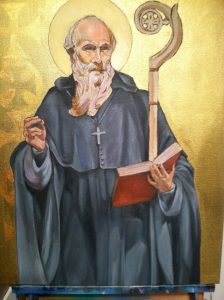
Listen and attend with the ear of your heart.
St. Benedict of Nursia
July 14
St. Kateri Tekakwitha
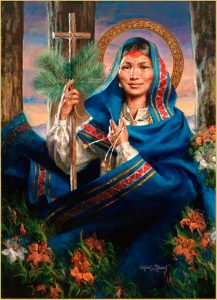
St. Kateri Tekakwitha, born in 1656, is the first Native American to be recognized as a saint by the Catholic Church. Her mother was an Algonquin, who was captured by the Mohawks and who took a Mohawk chief for her husband.
At the age of four, her entire family died of smallpox. She herself survived and was adopted by her uncle, but was terribly scarred and nearly blinded by the disease. When her adoptive parents arranged a husband for her, she refused to marry. At age 19, she converted to Catholicism, taking a vow of chastity and pledging to marry only Jesus Christ. She was viciously persecuted by her tribe and fled to a Christian community near Montreal.
Kateri was very devout and prayed for the conversion of her fellow Mohawks. According to the Jesuit missionaries that served the community where Kateri lived, she often fasted and when she would eat, she would taint her food to diminish its flavor. Always sickly, she sadly died only five years after her conversion. Admired for her piety and austere lifestyle, she became known as the “Lily of the Mohawks.” Her grave became a pilgrimage site for Native Americans and French settlers.
“Who will teach me what is most pleasing to God, that I may do it?”
St Kateri Tekakwitha
July 18
St. Camillus de Lellis
Camillus de Lellis was born in the Kingdom of Naples in 1550. He was a professional soldier who was powerfully built, some saying he topped six feet six inches in height. He fought for the Venetians against the Turks, and later for Naples. For his entire life, he suffered severely from a leg injury received while fighting the Turks. He was admitted to San Giacomo Hospital for treatment, but was made to leave due to his continual quarrelsomeness and reckless behavior.
He was addicted to gambling and, after his father died, he was penniless. Unable to find any other job to pay his gambling debts, he wound up working a construction job in a Capuchin friary. He was converted by the monks of that order and overcame his gambling and violent temper to attempt to join the Capuchins. But his novitiate with the Capuchins was repeatedly interrupted while he had his wound cared for. Humbled and contrite he once again was admitted to San Giacomo. Unable to pay for his care, he began ministering to the sick and dying.
Lacking education, he began to study with children to become a Jesuit when he was 32 years old. He was ordained in 1584.
After he received permission from his confessor, St. Philip Neri, he founded the Congregation of the Servants of the Sick (the Camillians or Fathers of a Good Death) to minister to the sick and dying in hospitals, prisons and private houses. Several hospitals were built by the Camillians and they formed the first field medical units in the battlefield, to minister to wounded troops in Hungary and Croatia. The red cross symbol was their sign of charity and service. He was so successful organizing assistance to the wounded on the battlefield, that the International Organization for assisting the sick would later adopt the Red Cross as its symbol and name.
Despite his wound, St. Camillus continued caring for the sick and wounded, often crawling from bed to bed when he could not walk. After years of suffering from that battle wound, he died in Rome in 1614.
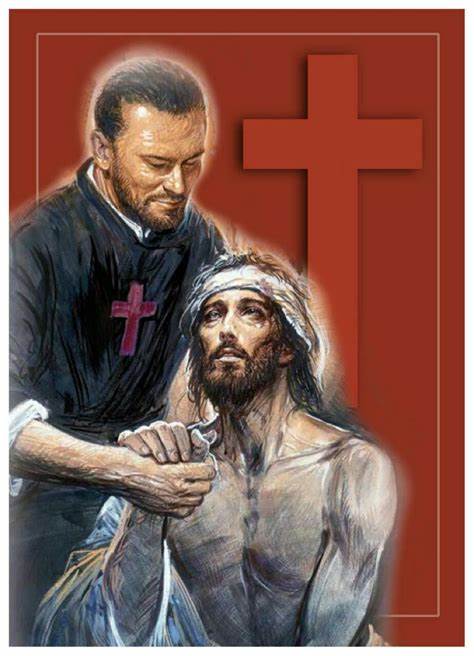
“I rejoice in what has been told me. We shall go into the house of the Lord.”
St. Camillus de Lellis, on learning that he was incurably ill
July 22
St. Mary Magdalene

Mary of Magdala was neither a prostitute nor – certainly not – the wife of the Lord. She was simply the woman possessed by seven demons who was rescued by Jesus and who followed him faithfully for the rest of her life. Angels were the messengers of the Incarnation; God granted this woman, one of us, to be the messenger of the Resurrection. She followed Him during His ministry, to the cross and to the empty tomb: She has always been the example of great love and great forgiveness, one of those close to Jesus who grasped the truth of God’s love for human beings and spent her life bearing witness to that love.
July 26
Sts. Anne and Joachim
In the Scriptures, Matthew and Luke provide a legal family history of Jesus, tracing his ancestry from his adoptive father Joseph back to Adam, to show that Jesus is the culmination of the history of our salvation. But his mother’s family is neglected; even the names “Joachim” and “Anne” come from a source written more than a century after Jesus died. Information concerning these parents of Mary is taken from apocryphal sources: The Gospel of the Nativity of Mary, the Gospel of PseudoMatthew, and the Protoevangelium of James. Whether we rely on the traditions about Mary’s childhood or make guesses from the information in the Bible, we see in her a fulfillment of many generations of prayerful persons, herself steeped in the religious traditions of her people.
Anne was the wife of St. Joachim. St. Anne became popular in the Roman Church in the thirteenth century, having been venerated in the Eastern Church since earliest times. Anne and Joachim had been married for a long time without children. Both prayed for an end to their barrenness, and an angel appeared to Joachim and to Anne, while he was away, telling them that she was pregnant. The angel also told Anne that the fruit of her womb “shall be blessed by all the world.”
Many legends have flourished about Anne and Joachim, but little is known about their lives. Veneration of Anne has been constant throughout the history of the Church, particularly in Constantinople. There she was included in the calendar, one of the oldest documents of Christendom. Her feast was instituted in the Roman calendar in 1481 by Pope Sixtus IV and universally by Pope Gregory XIII. In 1969 the feast day of St Joachim and the feast day of St Anne were joined together to be celebrated on July 26 as the feast of Saints Joachim and Anne.
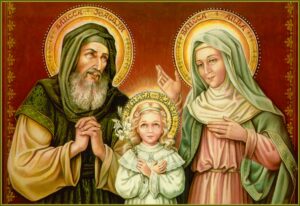
St. Anne is a patron saint of mothers, grandmothers, nursemaids, and women in labor; and of Naples and Florence
St. Joachim is a patron of fathers and grandfathers.
“O blessed couple, all the world is indebted to you, for it is by your means that it can offer to its Creator the most excellent gift possible, her who is worthy to be Mother of his only son.”
St. John Damascene
July 28
St. Alphonsa Muttathupadathu
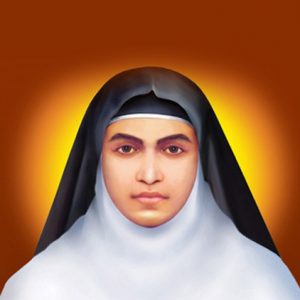
“I am a daughter of suffering. It is with stones of suffering and sacrifice that we build mansions for ourselves in heaven.”
St. Alphonsa Muttathupadathu
Saint Alphonsa Muttathupadathu, (1910–1946) was a Syro-Malabar Catholic Franciscan Religious nun, the First Woman Saint of India. Anna Muttathupadathu was born on August 19, 1910 at Arpookara in Kudamalloor near Kottayam District, Kerala, India.
In her early life she had a poor, difficult childhood and experienced loss and suffering early on in life. In 1923, Anna’s feet were burnt when she fell into a pit of burning chaff. This accident left her permanently disabled.A native of Kerala, India, Anna was orphaned at a young age. Her aunt planned a great marriage for her, but Anna wanted to be Christ’s bride. At length, her aunt yielded, and Anna joined the novitiate at a Franciscan Clarist Congregation, becoming Sr. Alphonsa of the Immaculate Conception.
Sister Alphonsa took her permanent vows on August 12, 1936. She taught high school at St. Alphonsa Girl’s High School, but was unable to teach for more than one term, due to serious illness. When a thief entered her room one night, she suffered a severe shock and lost her memory for several months. In the midst of these trials, Alphonsa suffered gladly. She spoke words of wisdom to those who visited her. Sometimes overcome by the burden she was on her community, she wished that her suffering would end; throughout her life, she was often sick with hemorrhages, sores, typhoid fever, and pneumonia. Yet she affirmed, “When I think of the many indignities Our Lord suffers at the hands of his own chosen people, I wish to suffer not only this, but far more until the end of the world…A day without suffering is a day lost.”
Alphonsa died at the age of thirty-five, and her tomb quickly became a place of prayer and miracles. Saint John Paul II said of her: “She came to love suffering because she loved the suffering Christ. She learned to love the cross through her love of the crucified Lord.”
July 31
St. Ignatius Loyola
St. Ignatius Loyola was born in 1491, one of 13 children of a family of minor nobility in northern Spain. As a young man, Ignatius Loyola was inflamed by the ideals of courtly love and knighthood and dreamed of doing great deeds.
But in 1521 Ignatius was gravely wounded in a battle with the French. While recuperating, Ignatius Loyola experienced a conversion. Reading the lives of Jesus and the saints made Ignatius happy and aroused desires to do great things. Ignatius realized that these feelings were clues to God’s direction for him.
Over the years, Ignatius became expert in the art of spiritual direction. He collected his insights, prayers, and suggestions in his book the Spiritual Exercises, one of the most influential books on the spiritual life ever is written. With a small group of friends, Ignatius Loyola founded the Society of Jesus or the Jesuits. Ignatius conceived the Jesuits as “contemplatives in action.” This also describes the many Christians who have been touched by Ignatian spirituality.
“If our church is not marked by caring for the poor, the oppressed, the hungry, we are guilty of heresy.”
St. Ignatius Loyola
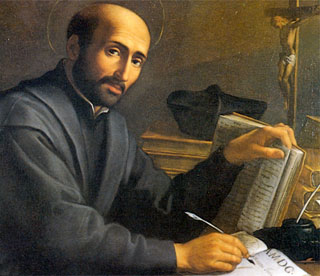
Retreats, of the Society of Jesus, of Loyola University, and of the Archdiocese of Baltimore

